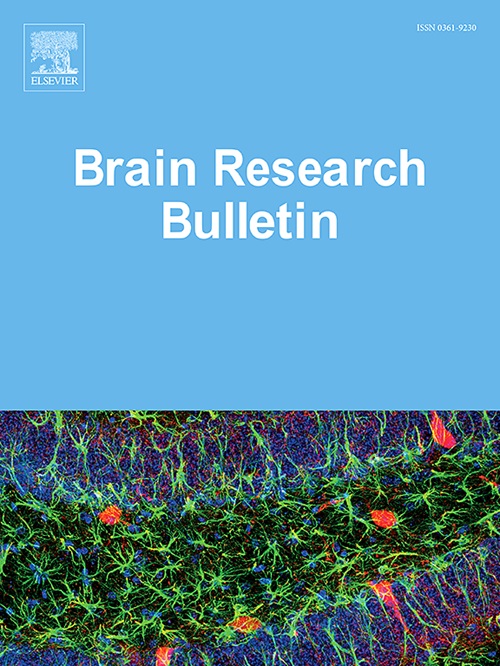Preconditioning with an enriched environment enhances neuroplasticity and functional recovery following cerebral ischemia-reperfusion injury
IF 3.5
3区 医学
Q2 NEUROSCIENCES
引用次数: 0
Abstract
Background
This study aimed to examine the effects of preconditioning with an enriched environment (EE) on neuroplasticity following cerebral ischemia-reperfusion (I/R) injury and to elucidate its underlying neuroprotective mechanisms. While prior research has indicated that EE preconditioning may mitigate neuronal apoptosis, the molecular pathways contributing to neuroplasticity enhancement post-I/R injury remain insufficiently characterized.
Methods
Male Sprague-Dawley rats were allocated into three experimental groups: (1) Middle cerebral artery occlusion (MCAO) with pre-ischemic EE exposure (PIEE), (2) pre-ischemic standard condition (SC) exposure with MCAO (PISC), and (3) pre-ischemic SC exposure with sham surgery (Sham). Neurological function and infarct volume were assessed three days post-MCAO. The expression levels of neuroplasticity-related proteins, including neurofilament (NF), synaptophysin (Syn), and microtubule-associated protein 2 (MAP-2), as well as neurotrophic factors such as nerve growth factor (NGF) and basic fibroblast growth factor (bFGF), were analyzed using western blot and immunohistochemical techniques. Correlation analyses were conducted to evaluate the relationship between protein expression and neurological outcomes.
Results
Compared to the PISC group, the PIEE group demonstrated significant improvements in neurological function and reduced infarct volumes. Expression levels of NF, Syn, and MAP-2 were elevated in the ischemic penumbra cortex in the PIEE group. Additionally, EE preconditioning resulted in increased expression of NGF and bFGF. These molecular changes were positively correlated with functional recovery in the MCAO model.
Conclusions
Pre-ischemic exposure to an enriched environment may enhance neuroplasticity and support functional recovery following cerebral I/R injury, potentially through the upregulation of neuroplasticity-associated proteins and neurotrophic factors. These findings support the development of EE-based interventions for ischemic stroke prevention and rehabilitation.
强化环境预处理增强脑缺血再灌注损伤后的神经可塑性和功能恢复。
背景:本研究旨在探讨富集环境预处理(EE)对脑缺血再灌注(I/R)损伤后神经可塑性的影响,并阐明其潜在的神经保护机制。虽然先前的研究表明,情感表达预处理可以减轻神经元凋亡,但对i /R损伤后神经可塑性增强的分子途径尚未充分表征。方法:雄性Sprague-Dawley大鼠分为3个实验组:(1)大脑中动脉闭塞(MCAO)伴缺血前EE暴露(pie),(2)缺血前标准状态(SC)伴MCAO暴露(PISC),(3)缺血前SC暴露伴假手术(sham)。mcao后3天评估神经功能和梗死面积。采用western blot和免疫组化技术分析神经可塑性相关蛋白(NF)、突触素(Syn)、微管相关蛋白2 (MAP-2)以及神经生长因子(NGF)、碱性成纤维细胞生长因子(bFGF)的表达水平。通过相关分析评估蛋白表达与神经预后之间的关系。结果:与PISC组相比,PIEE组表现出神经功能的显著改善和梗死面积的减少。缺血半暗皮层中NF、Syn、MAP-2表达水平升高。此外,EE预处理导致NGF和bFGF的表达增加。这些分子变化与MCAO模型的功能恢复呈正相关。结论:缺血前暴露于丰富的环境可能通过上调神经可塑性相关蛋白和神经营养因子,增强脑I/R损伤后的神经可塑性并支持功能恢复。这些发现支持基于脑电的缺血性卒中预防和康复干预的发展。
本文章由计算机程序翻译,如有差异,请以英文原文为准。
求助全文
约1分钟内获得全文
求助全文
来源期刊

Brain Research Bulletin
医学-神经科学
CiteScore
6.90
自引率
2.60%
发文量
253
审稿时长
67 days
期刊介绍:
The Brain Research Bulletin (BRB) aims to publish novel work that advances our knowledge of molecular and cellular mechanisms that underlie neural network properties associated with behavior, cognition and other brain functions during neurodevelopment and in the adult. Although clinical research is out of the Journal''s scope, the BRB also aims to publish translation research that provides insight into biological mechanisms and processes associated with neurodegeneration mechanisms, neurological diseases and neuropsychiatric disorders. The Journal is especially interested in research using novel methodologies, such as optogenetics, multielectrode array recordings and life imaging in wild-type and genetically-modified animal models, with the goal to advance our understanding of how neurons, glia and networks function in vivo.
 求助内容:
求助内容: 应助结果提醒方式:
应助结果提醒方式:


